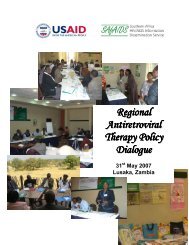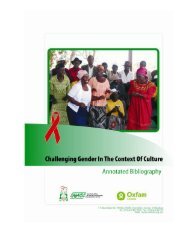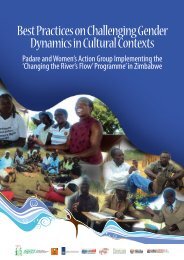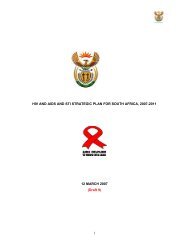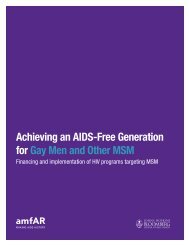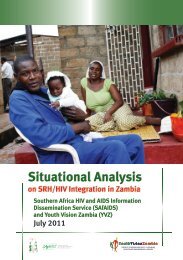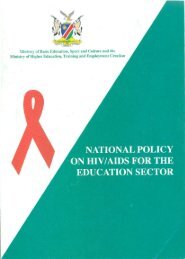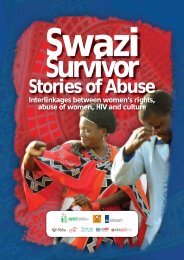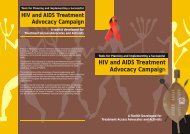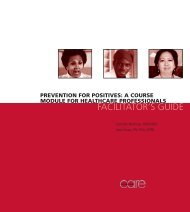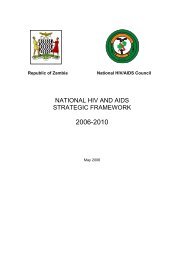Implementation of regional and international HIV prevention - SAfAIDS
Implementation of regional and international HIV prevention - SAfAIDS
Implementation of regional and international HIV prevention - SAfAIDS
- No tags were found...
You also want an ePaper? Increase the reach of your titles
YUMPU automatically turns print PDFs into web optimized ePapers that Google loves.
The survey findings show that the commitments <strong>of</strong> Swazil<strong>and</strong> <strong>and</strong> Zambia to <strong>regional</strong> <strong>and</strong><strong>international</strong> declarations on <strong>HIV</strong> <strong>and</strong> AIDS have yielded notable improvements in <strong>HIV</strong><strong>prevention</strong>, treatment, care <strong>and</strong> support strategies <strong>and</strong> services.Swazil<strong>and</strong>’s UNGASS report for 2008 shows that the country has made considerable effortsin <strong>prevention</strong>, care <strong>and</strong> support. The report states that Swazil<strong>and</strong> undertook a number <strong>of</strong><strong>HIV</strong> <strong>prevention</strong> strategies, among them voluntary counselling <strong>and</strong> testing (VCT), condompromotion, information, education <strong>and</strong> communication (IEC), PMTCT <strong>and</strong> blood safety.Achievements under <strong>prevention</strong> include development <strong>of</strong> a national policy on blood safety in2000 <strong>and</strong> adoption <strong>of</strong> national guidelines by 2001. The percentage <strong>of</strong> donated blood screenedfor <strong>HIV</strong> with an external quality assurance scheme is 100%.<strong>HIV</strong> prevalence among Swazi people aged 15-49 years has stabilised, but at a high rate <strong>of</strong>about 26.1% from 2000 to date. The period <strong>of</strong> stabilisation coincides with the period in whichSwazil<strong>and</strong> signed a number <strong>of</strong> declarations <strong>and</strong> conventions relating to <strong>HIV</strong>. One wouldtherefore deduce that the conventions <strong>and</strong> declaration might have to some extent helped instabilising the high <strong>HIV</strong> prevalence rates in Swazil<strong>and</strong>.Having developed its first PMTCT guidelines in 2002, <strong>HIV</strong> testing among pregnant womenincreased from 15% in 2004 to 66% in 2006. The percentage <strong>of</strong> <strong>HIV</strong> positive pregnant mothersunder PMTCT programme was 62% in 2006 <strong>and</strong> 64.8% in 2007. The country is thus on courseto reach its committed target <strong>of</strong> 80% by 2010. (Universal Roads Access to Prevention Treatment<strong>and</strong> Care <strong>and</strong> Support in Swazil<strong>and</strong>, November 2007).In relation to care <strong>and</strong> support, the UNGASS report for 2008 states that the GoS focusedon treatment, care <strong>and</strong> support by highlighting the need for increased access <strong>and</strong> properutilisation <strong>of</strong> ART; clinical management <strong>of</strong> opportunistic infections; diagnostic testing <strong>and</strong>counselling; institutional <strong>and</strong> home-based care; <strong>and</strong> palliative care. Achievements undercare <strong>and</strong> support include rolling-out <strong>of</strong> ART. Swazil<strong>and</strong> achieved the WHO ‘3 by 5’ targets <strong>of</strong>13,000 patients on ART by 2005. Currently, 35% <strong>of</strong> adults <strong>and</strong> 31% <strong>of</strong> children with advanced<strong>HIV</strong> infection are receiving ART. The country’s target, by end <strong>of</strong> 2008, is 50%. Free ART wasintroduced in 2003 with 3,200 accessing it in 2004 <strong>and</strong> 25,000 in 2007. More healthcare workershave been trained since 2005 <strong>and</strong> there has been a scaling up <strong>of</strong> voluntary testing <strong>and</strong>counselling <strong>and</strong> supplying free Nevirapine for <strong>HIV</strong> positive pregnant women.Zambia, like Swazil<strong>and</strong> has scored positive results in implementing <strong>HIV</strong> <strong>prevention</strong>,treatment, care <strong>and</strong> support in line with several <strong>regional</strong> <strong>and</strong> <strong>international</strong> declarations towhich the country is a signatory.8Recent studies, including the ZDHS 2008 <strong>and</strong> UNAIDS update 2008, have shown that adult(15-49 years) prevalence has been declining from 1995. Current statistics indicate that the<strong>HIV</strong> prevalence rate among the adult population (15-49 years) has declined from about 16%in 2005 to about 14.3% in 2007. These declines coincide with periods in which the ZambianGovernment, like Swazil<strong>and</strong> has committed itself to various declarations <strong>and</strong> conventions,including the implementation <strong>of</strong> free ART policy.



